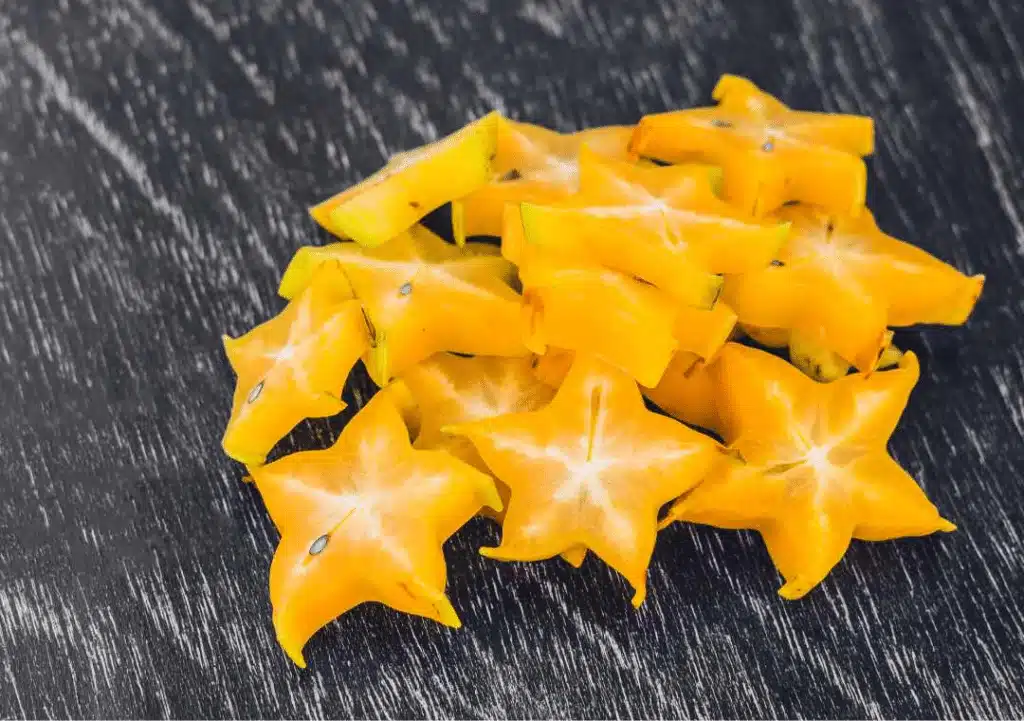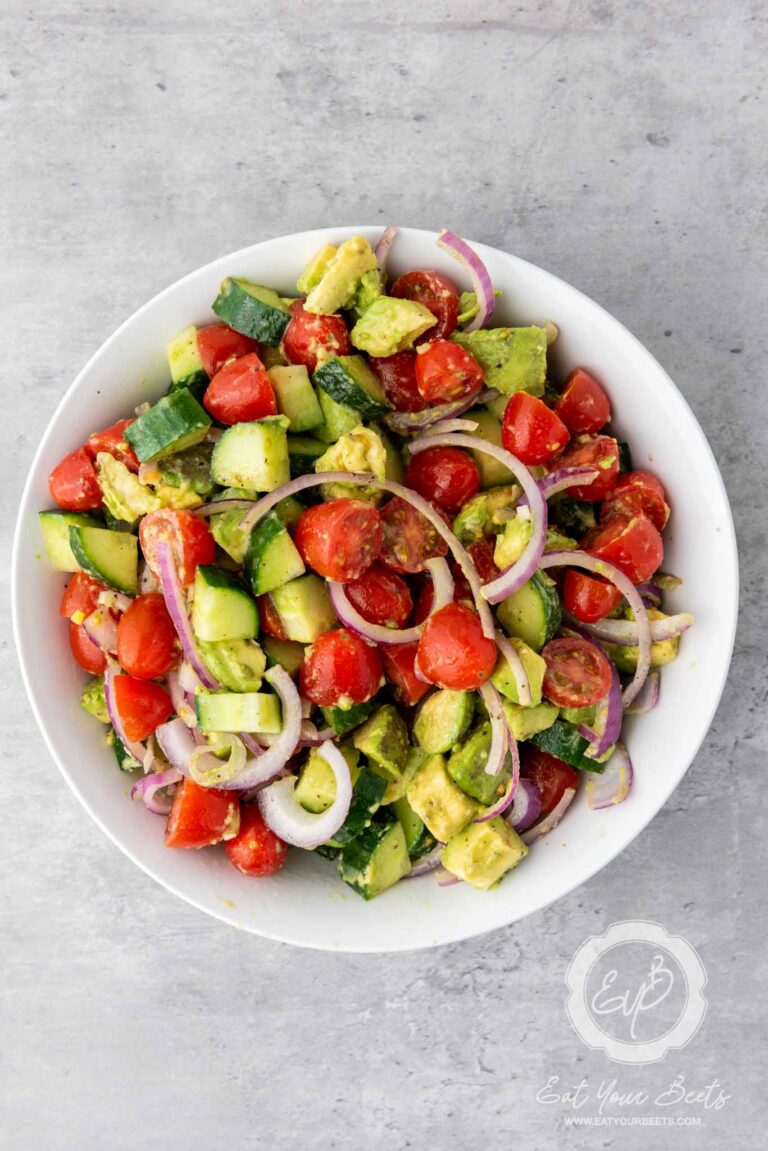What Does Star Fruit Taste Like?
Have you ever seen a star fruit and wondered what it tastes like? You may have spotted one at the grocery store or heard about it from friends, but either way, you haven’t entirely found the courage to take that first bite. This article will answer the question, what does star fruit taste like? It’s a cross between strawberry, lemon, pineapple and even sour green apple makes up its delicious taste.
For anyone who loves unusual fruits as much as they love their favorite cuisine, star fruit may be your new go-to snack or dinner side dish!

Contents
What Is Star Fruit?
This tropical fruit has gained popularity for its unique appearance and delightful taste. The entire fruit takes the shape of a star when sliced crosswise, calling it “star-shaped fruit.”
Star fruit is a citrus fruit that grows on trees in the genus Citrus. Its surface is characterized by waxy skin that may have some brown spots, which are entirely normal.
The fruit also showcases prominent brown ridges along its five points, adding to its distinctive look. You may find a few tiny black seeds inside the star fruit, especially the fully ripened ones.
When the fruit is ready to be consumed, it will turn yellow, signaling its perfect ripeness. Both the skin and the flesh of this exotic fruit are edible. Star fruit’s texture is similar to kiwi fruit or other juicy fruit.
Origin of Star Fruit
Star fruit, also known as carambola, is a unique and exotic fruit that originated in Southeast Asia. This distinctive fruit is commonly found in tropical areas, where it thrives in the warm climate and fertile soil.
Over time, the popularity of star fruit has spread to other countries worldwide, including South America, Central America, and the Caribbean.
Star fruits have two primary harvesting seasons in South Florida: August to September and December through February. Depending on the planting schedule of local growers, it’s possible to find this fruit throughout the year.
What Does a Star Fruit Taste Like?
Ripe Star Fruit
- Ripe star-fruits taste sweet and slightly tart flavor, often compared to a combination of citrus fruits such as pineapple, orange, and lemon.
- The sweetness of the ripe star fruit comes from its high sugar content, making it a delicious and refreshing treat to eat raw or add to various dishes and beverages.
- When fully ripe, the star fruit’s texture becomes juicy and tender, enhancing its overall taste.

Unripe Star Fruit
- An unripe star fruit has a sour flavor, which is more pronounced than a ripe one. This is due to the higher acidity levels in the fruit, reminiscent of other citrus fruits like lime or green apple.
- The sour taste of unripe star fruit can be pretty intense and may not be enjoyable for everyone. However, some people appreciate and use the tangy flavour in recipes that call for a sour element, such as salads or pickles.
- Unlike ripe star fruits, unripe ones have a firmer texture, making them more challenging to eat raw.

Does Star Fruit Taste Like Banana?
Star fruit has a unique and exotic flavor that is quite different from the taste of a banana. As you bite into the succulent and juicy star fruit, you’ll notice a subtle sweetness reminiscent of a mix between grapes, apples, and citrus fruits.
Its refreshing taste is accompanied by a slightly tart undertone, which perfectly balances the overall flavor profile of this tropical delight.
While bananas have a more distinct and creamy taste, star fruit offers a crisp, tangy experience that leaves your taste buds craving more.

Is Star Fruit Sweet or Sour?
Star fruit has a distinctive shape and flavor profile. The taste of star fruit can vary depending on its ripeness, with the ripe fruit offering a delightfully sweet taste, while the unripe or slightly underripe fruit leans more towards a tangy, sour flavor.
On the other hand, the sourness of unripe star fruit can be pretty sharp and may not be suitable for everyone’s palate..
Can You Eat Overripe Star Fruit?
Overripe star fruit is still safe to consume, but some factors must be considered. When a star fruit becomes overripe, it loses its crisp texture and vibrant flavor, often becoming mushy and bland.
In some cases, overripe star fruit may develop an off taste or smell, indicating it’s starting to spoil. If you notice any signs of mould or an unpleasant odour, it’s best to discard the fruit.
However, if the overripe star fruit appears in good condition, you can still enjoy it in smoothies, jams, or cooked dishes where the texture and taste are less noticeable.
Can Star Fruit Eaten Raw?
Yes, you can eat star fruit raw! Typically, it is consumed raw and without any additional flavoring. Many people enjoy consuming it fresh by cutting it into its signature star-shaped slices. The whole fruit, including its waxy exterior, can be, making it simple to enjoy in its raw form.
Eating raw star fruit allows you to fully appreciate its natural flavors.
How Fast Does Star-Fruit Ripen?
This fruit typically takes around 3-4 weeks to ripen after flowering. Various factors, including temperature, humidity, and exposure to sunlight, can influence the ripening process.
When the fruit ripens, its color changes from green to a vibrant yellow, developing a distinct, sweet aroma.

What Goes Well With Star Fruit?
Star fruit goes well with different recipes.
- Savory dishes: Star fruit can be incorporated into savory dishes like salads, stir-fries, and even grilled alongside proteins like chicken or shrimp for a unique and delicious combination.
- Other Tropical fruits: Star fruit pairs wonderfully with various fruits in a fruit salad. Combining it with other tropical fruits such as mango, pineapple, and papaya makes it an excellent addition to fruit salads or smoothies.
- Citrus fruits: Combining star fruit with citrus fruits like oranges, grapefruits, and lemons adds a tangy twist and enhances the overall flavor profile of the dish.
- Berries: Pairing star fruit with berries like strawberries, raspberries, and blueberries creates a colorful and visually appealing dish and offers a delightful blend of sweet and tart flavors.
- Herbs and spices: Enhance the taste of star fruit by adding herbs and spices like mint, basil, or ginger to create a more complex and exciting flavor experience.
- Desserts: Star fruit’s natural sweetness makes it an ideal garnish for desserts like ice cream, cakes, and tarts, adding a touch of exotic flair.
- Beverages: Blend star fruit with water, fruit juice, or coconut water to create a refreshing and nutritious drink that pairs well with various meals.
- Condiments and preserves: Incorporate star fruit into recipes for jams, chutneys, or salsas to add a tropical twist to your favorite dishes and elevate their flavors.
- Star Fruit Juice: Cut the star fruits into thin pieces and place them in a blender. Blend Combine and mix until a smooth texture is achieved, incorporating a bit of water or orange juice to assist with the consistency. Pass the blended concoction through a fine mesh sieve to eliminate leftover pulp. Pour the star fruit juice into a glass with ice, garnish with a star fruit slice or mint sprig, and enjoy your refreshing tropical drink.
What Are the Health Benefits of Eating Star Fruit?
Star fruit, also known as carambola, offers numerous health benefits, making it a nutritious addition to your diet.
This tropical is abundant in Vitamin C, which makes it a powerful partner in fighting skin conditions and encouraging vibrant skin.
Research also indicates that eating star fruit may reduce blood sugar levels.
Moreover, the high Vitamin C content in star fruit helps fight inflammation, which can benefit individuals suffering from stomach ulcers.
As an added bonus, the fruit’s edible nature allows for easy consumption, and its rich source of antioxidants further enhances its ability to support overall health.
With its unique combination of nutrients, star fruit provides a convenient way to reap the health benefits of this tropical treasure.
Why You Should Avoid Star Fruit?
Star fruit, while an exotic and delicious treat for many, can pose serious health risks for individuals with kidney disease.
When consumed by those with compromised renal function, this seemingly harmless fruit can lead to a dangerous buildup of toxins in the body.
This is because star fruit contains high levels of oxalates, substances that can accumulate in the kidneys and form painful kidney stones.
Additionally, the fruit’s neurotoxins can cause neurological symptoms ranging from mild confusion to life-threatening seizures, particularly those with kidney diseases.
Therefore, it is crucial for individuals with kidney-related health issues to avoid star fruit and consult their healthcare provider about safe dietary choices.
How to Store Star Fruit?
You can store star fruit by following a few simple steps is essential to ensure they remain fresh and delicious.
Carefully rinse the mature star fruits under flowing water and lightly dab them with a hygienic towel to dry. Next, place the star fruits in an open container or plastic bag with small holes for ventilation, preventing excess moisture buildup.
Store the ripe star fruits in the refrigerator’s crisper drawer, where they last for about a week. Alternatively, if your star fruit is unripe, allow it to mature at room temperature, rotating it occasionally to ensure uniform ripening.
Once fully ripe, follow the same storage steps mentioned earlier to preserve freshness and flavor.
Where to Buy Star Fruit?
If you’re looking to buy star fruit, you’re in luck, as they can be found at your local grocery store. Most stores carry this exotic and delicious fruit, making it easily accessible for anyone interested in trying something new.
To find star fruit, head to the produce section of your favorite grocery store and watch for its unique shape and vibrant color.
How to Choose a Star Fruit?
Whenever buying star fruit, it’s essential to pay attention to the color and texture of the fruit. Look for a star fruit with a vibrant light green to a bright yellow hue, indicating ripeness.
Avoid fruits with dark green or brown edges, as these are signs of under-ripeness or over-ripeness. Press the fruit to check its firmness; a ripe star fruit should yield slightly to gentle pressure.
Can You Grow Star Fruit at Home?
Growing a star fruit tree at home is an exciting and rewarding endeavor for those who love this unique tropical fruit. First, you must obtain a healthy star fruit sapling or seeds from a reputable nursery.
Plant your star fruit tree in a spacious area with well-draining soil, and provide it with plenty of sunlight and warmth, as these trees thrive in tropical climates. As your star fruit tree matures, it will produce many delicious fruits you can harvest and enjoy.
With a little patience and care, you can have your star fruit tree producing a bounty of fresh fruits, ready to be transformed into delightful dishes and refreshing drinks at home.
What Does Star Fruit Taste Like?
Star fruit has a unique flavor that blends sweet, sour and tart notes.
The flesh of this fruit is juicy and crisp, resembling the texture of apples. Its flavor is often compared to a mix of citrus fruits, such as oranges, limes and grapefruits, making it an interesting and flavorful addition to fruit salads, smoothies and desserts.
Star fruit is a delicious and versatile tropical fruit with many health benefits, making it a worthy addition to any diet.
While there are some potential risks for individuals with kidney-related health issues, star fruit can still be enjoyed in moderation when following the proper precautions. If you’re searching for a scrumptious and wholesome treat, try star fruit!






